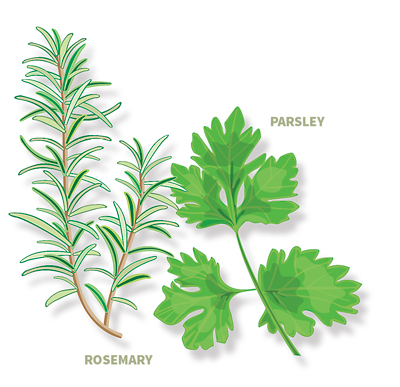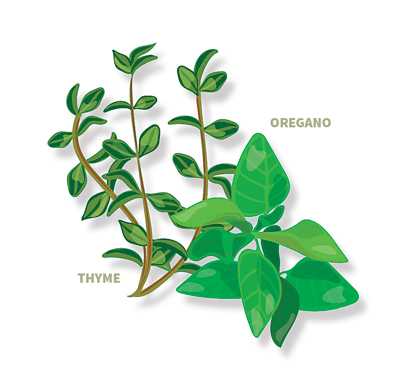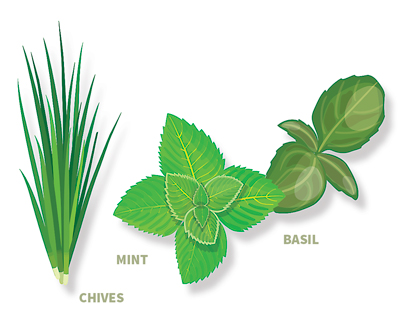Reaching into your pantry and grabbing an old jar of dried herbs to top off that special dish you created can quickly muddle your mood. When you opt for fresh herbs, you boost your positive cooking energy and your nutrient intake while adding tons of flavor. The good news is finding the herbs that work best with the food you love is easy and fun. Growing herbs is a great introduction to gardening, and a lot of them come back year after year. Let’s take a look at some favorites!

Rosemary is a woody perennial that loves a hot climate and can grow very large. Try
growing rosemary in an oversized container outdoors or in the ground in a sunny location. Add rosemary to hearty dishes, such as soups and bean stews or lemon-grilled chicken. Finely chop rosemary with garlic and enjoy with roasted potatoes. Keep a few stems in a jar with clean water in your kitchen for easy access and a nice fragrance.
Italian flat-leaf parsley is a nutrient-dense herb packed with vitamins. This parsley thrives in well-drained soil in a planter in a sunny kitchen window, grows easily, and should be planted every year. Use it in pesto, or to top off your pastas, rice salads, grilled fish, or add it to your juicing routine.
 Thyme is a flavor booster in so many dishes! It grows well through the winter making it a great choice to add to your garden. Toss thyme into broths or soups. Use it with braised short ribs, or add it to compound butters to top off that grilled portobello mushroom.
Thyme is a flavor booster in so many dishes! It grows well through the winter making it a great choice to add to your garden. Toss thyme into broths or soups. Use it with braised short ribs, or add it to compound butters to top off that grilled portobello mushroom.
Oregano is a perennial that grows best outdoors. This herb is potent and adds amazing flavor to pasta salads, beans, marinated feta, and sauces. To dry oregano, bunch it up with some string and hang it upside down for a few days. Rub between your fingers over a bowl and collect the leaves, then store your oregano in an airtight container
to use all winter.
Chives are perennials that have beautiful purple blooms each spring and are best grown outdoors. Chives also improve heart health and promote healthy skin and vision. Use chives for a mild onion flavor in potato salad and marinades, or add it to vinaigrette or dips.
Mint is a perennial that wants all the space, so plant it in a pot or in an area where it can spread. Mint grows well indoors in a sunny window. This herb will boost flavor in unexpected ways. Try adding mint to grain bowls, Greek pastas, pesto, or to yogurt for a cooling side to a spicy dish. You can also make a tea to aid with digestion or a simple syrup for cocktails.
Dill grows fast and is an annual that is best planted from seed. This herb is good for showing the kids how to collect seeds after
the flowers have died back. Dill goes well with cucumbers and carrots – think pickles and yogurt dips. Use dill to dress up your zoodles (zucchini noodles), add to your potatoes, or make a sauce for your salmon.
 Cilantro, an annual that is best planted from seed, flowers very early, making it very pungent and hard to use. You can buy this one in bunches from the produce section and add it to your coleslaw, make a chimichurri, or add it to a salad with carrot and lime. It’s a great addition to your taco bar. Be warned – cilantro is an herb that many folks dislike or even have a reaction to, so check with your guests before making it the star of any dish.
Cilantro, an annual that is best planted from seed, flowers very early, making it very pungent and hard to use. You can buy this one in bunches from the produce section and add it to your coleslaw, make a chimichurri, or add it to a salad with carrot and lime. It’s a great addition to your taco bar. Be warned – cilantro is an herb that many folks dislike or even have a reaction to, so check with your guests before making it the star of any dish.
Sage is a woody perennial that is lovely to add to your container garden as its beautiful broad leaves have tons of texture. It has many health benefits and can help with reducing anxiety and depression. This herb is strong and is best with hearty dishes, think roasted turkey. You might try pairing it with honey or maple syrup for a sweet and savory effect, or fry it in butter for ravioli. This herb is easy to dry by bunching and hanging – just crumble the leaves for later use. Store in an airtight container.
Basil is the annual that’s easy to grow indoors and out and loves full sun. Use for pastas, pesto, and caprese salad. Try using it in your drinks. Use a sharp knife when cutting, or better yet, just tear to reduce bruising and browning.
Storing Your Fresh Herbs
Long-stemmed herbs – such as parsley, rosemary, chives, and cilantro – need to be trimmed. Cut off the end of the stems, stick in a tall glass of water, and refrigerate. Use within four to five days.
Stocky herbs – like thyme, sage, oregano, and mint – can all be kept with a damp paper towel in a resealable bag in the fridge. Use within a week.
Basil is best kept in a container on the counter. It does not like to be cold. Try using an old salad container.





